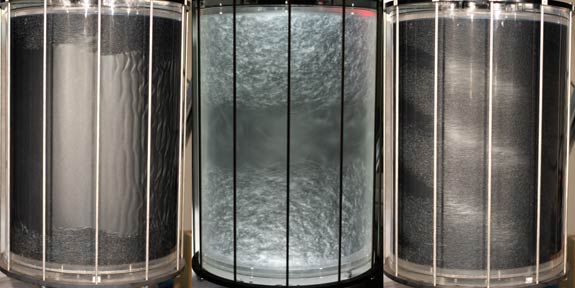Transitional Patterns in Cyclonic Flows
M.J. Burin
C.J. Czarnocki
Department of Physics
California State University, San Marcos

Fluid flows bound between rotating cylinders can produce a wealth of patterns as they transition between a laminar and turbulent state.
Fluid flow bound between rotating cylinders, or Taylor-Couette flow, is one of the most studied and celebrated experimental arrangements in fluid dynamics for the investigation of flow instabilities and the transition to turbulence. Typically the inner cylinder is spun – this leads to a transition to turbulence that is analogous to heat convection and is well studied. When only the outer cylinder is spun the flow also may transition to turbulence, but through an entirely different manner. Such flows become turbulent from the presence of shear, as also happens in pipe flow. Between the laminar and turbulent state a wealth of patterns may be observed, as the three examples pictured here illustrate. A. If the flow is rapidly accelerated, and if the gap between cylinders is narrow enough, roll waves may develop – this appears to be the rotating version of the waves that develop in a thin layer of water as it flows down a sidewalk. B. When the flow is accelerated, but to a mild speed, turbulence initially develops from the end-boundaries, but is not sustained; it eventually dies out. C. If the flow becomes turbulent however, but is then slowed down a bit, it may develop ‘spiral turbulence’. This peculiar intermediate state resembles a classic barbershop pole, featuring inclined alternating bands of turbulent and smooth flow. The origins of this pattern are still not fully understood.
This research is partially funded by the Research Corporation for Science Advancement,a foundation dedicated to science since 1912.
Reporters and Editors
Reporters may freely use this image. Credit: M.J. Burin, CSU San Marcos (2010).
